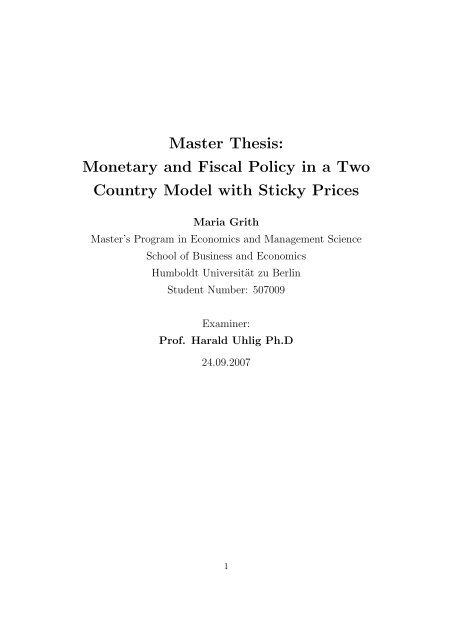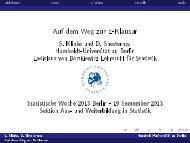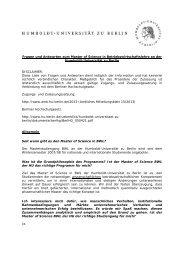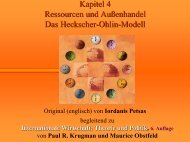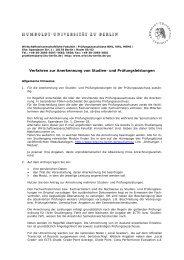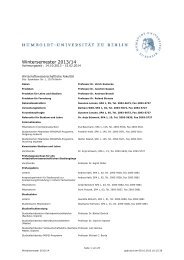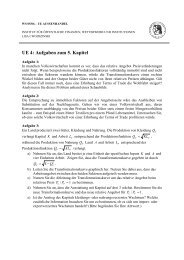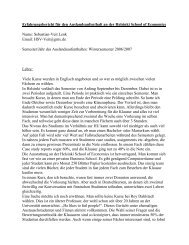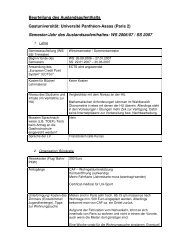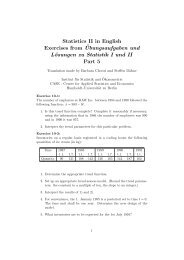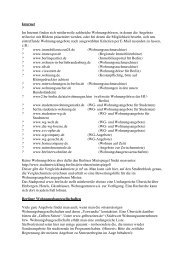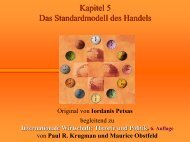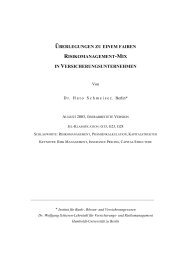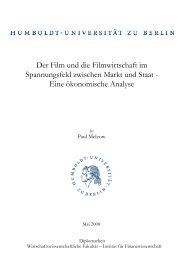Master Thesis - Humboldt-Universität zu Berlin
Master Thesis - Humboldt-Universität zu Berlin
Master Thesis - Humboldt-Universität zu Berlin
You also want an ePaper? Increase the reach of your titles
YUMPU automatically turns print PDFs into web optimized ePapers that Google loves.
<strong>Master</strong> <strong>Thesis</strong>:<br />
Monetary and Fiscal Policy in a Two<br />
Country Model with Sticky Prices<br />
Maria Grith<br />
<strong>Master</strong>’s Program in Economics and Management Science<br />
School of Business and Economics<br />
<strong>Humboldt</strong> Universität <strong>zu</strong> <strong>Berlin</strong><br />
Student Number: 507009<br />
Examiner:<br />
Prof. Harald Uhlig Ph.D<br />
24.09.2007<br />
1
Contents<br />
1 Abstract 4<br />
2 Introduction 4<br />
3 Literature 7<br />
4 The Model 9<br />
4.1 Households . . . . . . . . . . . . . . . . . . . . . . . . . . . . 9<br />
4.1.1 Income, consumption and savings . . . . . . . . . . . . 10<br />
4.1.2 Labor market: . . . . . . . . . . . . . . . . . . . . . . . 11<br />
4.2 Intermediate firms . . . . . . . . . . . . . . . . . . . . . . . . 12<br />
4.3 Final goods sector . . . . . . . . . . . . . . . . . . . . . . . . . 13<br />
4.4 Imported goods sector . . . . . . . . . . . . . . . . . . . . . . 14<br />
4.5 Government . . . . . . . . . . . . . . . . . . . . . . . . . . . . 17<br />
4.6 Balance of Payments . . . . . . . . . . . . . . . . . . . . . . . 17<br />
4.7 Market equilibrium . . . . . . . . . . . . . . . . . . . . . . . . 18<br />
5 Model analysis 19<br />
5.1 Households: Optimization problem . . . . . . . . . . . . . . . 19<br />
5.2 Intermediate firms: Optimization problem . . . . . . . . . . . 26<br />
5.3 Importing firms: Optimization problem . . . . . . . . . . . . . 30<br />
5.4 Final goods sector: Optimization problem . . . . . . . . . . . 31<br />
5.5 Monetary and fiscal policy . . . . . . . . . . . . . . . . . . . . 36<br />
6 Impulse response functions for the shocks 36<br />
6.1 TFP shock . . . . . . . . . . . . . . . . . . . . . . . . . . . . . 37<br />
6.2 UIRP shock . . . . . . . . . . . . . . . . . . . . . . . . . . . . 37<br />
6.3 Government consumption shock . . . . . . . . . . . . . . . . . 38<br />
6.4 Monetary policy shock . . . . . . . . . . . . . . . . . . . . . . 38<br />
6.5 Investment-specific technology shock . . . . . . . . . . . . . . 38<br />
6.6 Consumption tax shock . . . . . . . . . . . . . . . . . . . . . . 38<br />
6.7 Capital tax shock . . . . . . . . . . . . . . . . . . . . . . . . . 39<br />
6.8 Labor tax shock . . . . . . . . . . . . . . . . . . . . . . . . . 39<br />
2
6.9 ROW demand shock . . . . . . . . . . . . . . . . . . . . . . . 39<br />
6.10 Oil price shock . . . . . . . . . . . . . . . . . . . . . . . . . . 39<br />
6.11 ROW importing price shock . . . . . . . . . . . . . . . . . . . 40<br />
6.12 Prices and wages mark-up shock . . . . . . . . . . . . . . . . . 40<br />
7 Conclusions 41<br />
8 Refferences 42<br />
9 Appendixes 45<br />
9.1 Appendix 1 . . . . . . . . . . . . . . . . . . . . . . . . . . . . 45<br />
9.2 Appendix 2 . . . . . . . . . . . . . . . . . . . . . . . . . . . . 48<br />
10 Dynare code 56<br />
3
1 Abstract<br />
In this paper we develop a dynamic stochastic general equilibrium (DSGE)<br />
model for an open economy where the uncovered interest rate parity is not<br />
required to hold. We extend the open economy DSGE model of De Walque,<br />
Smets and Wouter (2005) by incorporating stochastic fiscal policy into the<br />
model. The model includes several features of market rigidities. The focus<br />
is on explaining the theoretical model thoroughly and analyzing the impulse<br />
response function under calibrated parameters in Dynare.<br />
Keywords: DSGE model; New open economy; Interest rate parity; Real and<br />
Nominal Rigidities<br />
2 Introduction<br />
Our motivation for the model is to construct a DSGE open economy model<br />
with sticky prices and wages to link the euro area and the US using specific<br />
variables. The model is a version of the ”New Open Economy Model”<br />
(NOEM), and contains the salient features of its class with respect to the<br />
optimizing behaviour of the microeconomic units, firms and households, sluggishness<br />
of prices and wages, goods aggregation, exchange rate and current<br />
account, and the monetary authority. Hereafter, domestic intermediate and<br />
importing monopolistically competitive firms set prices and households set<br />
wages in a Calvo mechanism. This helps to explain inflation inertia and output<br />
persistence. A representative aggregator combines complete sets of differentiated<br />
types of labor, intermediate and imported goods and distributes<br />
the final consumption goods. Capital accumulation is subject to adjustment<br />
costs, so is capital intensity and domestic-foreign inputs ratio. Monetary<br />
policy intervenes in the form of interest rate setting rules; money is not explicitly<br />
modeled but assumed to be embodied in the utility function.<br />
The domestic block emulates the economy from Smets and Wouters’ previous<br />
work on the closed economy, but with a reduced number of stochastic shocks.<br />
4
Preference shocks, inflation objective shocks, and labor supply shocks are excluded<br />
from the model. The main difference with respect to the intermediate<br />
production sector comes from the input of oil and non-oil inputs in the production<br />
function. In addition, distortional taxes on labor income, individual<br />
consumption, and capital earnings are taxed by the government to finance<br />
its own consumption; a part of the tax revenues return to the households as<br />
lump-sum transfers. A level of economic openness is achieved by integrating<br />
both models through international trade in goods and assets. The imperfect<br />
international capital market is stochastically represented, which helps to explain<br />
the departure from the uncovered rate parity condition and high short<br />
time volatility of exchange rate. The incomplete pass-through in the model<br />
originates only from nominal price rigidities. Current account is determined<br />
by an inter-temporal budget constraint, a typical assumption in the NOEM<br />
models. The set of variables and shocks is extended in order to express the<br />
net-trade flows, the import and consumption price inflation, the rate of depreciation<br />
and the oil price fluctuations.<br />
In the present paper, we keep the initial specification of the open economy<br />
relatively simple. Richer models that explain the depreciation rate evolution<br />
address endogenously determined risk premiums on foreign currency associated<br />
with net foreign assets holdings i.e. Bergin (2005), Adolfson, Laséen,<br />
Lindé, and Villani (2005); or with monetary policy actions i.e. Obstfeld and<br />
Rogoff (2002). Bergin (2005) investigates the importance of producer currency<br />
pricing for exporters (pricing to market) and finds that this assumption<br />
is supported by the data.<br />
The home bias helps to explain elasticity of substitution between domestic<br />
and foreign goods. In this setup the authors follow Corsetti et al. (2003) to<br />
determine the value of the elasticity of substitution via an estimated share<br />
of imports in the domestic service sector. Through the elasticity of substitution<br />
and relative domestic and foreign prices, the cost minimization objective<br />
function of the representative agent determines the proportions of various<br />
goods in the final product.<br />
5
In this paper we do not propose to analyze the difference between high and<br />
low elasticity of substitution, as it is still a subject of controversy among<br />
researchers. Instead we simulate our model using estimated parameters for<br />
low elasticity of substitution, as it is shown by the authors performs better<br />
marginally. However, the difference is small and under certain assumptions<br />
both cases can be valid. Our purpose is to investigate the changes in the<br />
impulse-response function by the introduction of taxes for the case of low<br />
elasticity of substitution. We assume that in the steady state these taxes<br />
are not zero by following the Trabant and Uhlig (2006) calibrated values for<br />
these types of taxes in Europe and the U.S. These values might not be entirely<br />
accurate: first because of the time horizon, and secondly because the<br />
Euro Area does not include all the countries for which the average taxes have<br />
been computed. But for our exercise we consider them to be appropriate.<br />
In this version of the model the standard assumption of constant elasticity of<br />
demand with respect to prices is altered for the intermediate producers; as<br />
a result, an additional parameter enters the price setting problem, following<br />
Eichenbaum and Fischer (2004).<br />
The first concern of our paper is to explain the theoretical model in a detailed<br />
way that would allow us to make subsequent extensions to it. The<br />
second part, is the analysis of the impulse response functions of the model<br />
as implemented in Dynare and the Toolkit. In the appendix, we attempt to<br />
introduce an estimate of the model in Dynare.<br />
The analysis of the domestic sector is complicated by the introduction of imports<br />
that combine with domestic goods in different stages. These feed back<br />
on the marginal cost and wages, and influencing real domestic variables. The<br />
external sector uses mainly proportions in which imports enter the final products,<br />
without very complex analytical derivations otherwise. The elasticity<br />
of demand for intermediated goods as a departure from the standard Dixit-<br />
Stiglitz assumtion is embeded in the model, and analysed. Taxes modify<br />
6
the households behavior with respect to consumption, investment, and labor<br />
supply decisions.<br />
3 Literature<br />
From the modeling perspective, NOEM can be seen as an extensions on a New<br />
Keynesian closed economy (e.g. Gali (2002)). It uses microeconomic RBC<br />
methodology to model the optimization function of the representative agent<br />
and expectations, as well as nominal and real rigidities to model frictions in<br />
the market. The theoretical foundations of the NOEM differ mainly with<br />
respect to the assumptions of the price setting mechanism for exported and<br />
imported goods, the nature of the goods being traded and their distribution<br />
in the domestic market, the nature of the international capital markets,and<br />
the consumer bias for domestically vs. imported goods. In addition, different<br />
stochastic shocks complement the DSGE models to explain the fluctuations<br />
in the main economic indicators.<br />
The challenge to match New Keynesian models to the empirical evidence has<br />
prompted academics and researchers to look for adequate optimization tools<br />
that can fully account for the data. Building on Leeper and Sims’s (1994) fullinformation<br />
maximum-likelihood methods and Schorfheide’s (2000) Bayesian<br />
techniques, Smets and Wouters (2003) successfully estimate an optimizationbased<br />
DSGE model of the Euro Area. Significant contribution is brought by<br />
Christiano, Eichenbaum, and Evans (2005) in explaining the monetary policy<br />
shocks. Similar achievements contributed to the DSGE models being used<br />
intensively for the analysis of the optimal monetary policy and of international<br />
policy coordination.<br />
While closed economy studies have been quite abundant, there is relatively<br />
little empirical work on open economy. Recently, Bergin (2004) developed a<br />
two-country model that combines features of international real business cycle<br />
models with the NOEM; Adolfson, Laséen, Lindé, and Villani (2005) extend<br />
a model with imperfect international risk sharing that follows the framework<br />
7
of Christiano, Eichenbaum and Evans (2005); Lubik and Schorfheide (2005)<br />
built up a small-scale two-country model. They are the pioneers in estimating<br />
their open economy models using Bayesian techniques.<br />
Following these advances in estimating the DSGE closed economy, Walque,<br />
Smets and Wouter (2005) launched a new initiative to estimate large scale<br />
models using over 20 shocks and time series in their model. Their theoretical<br />
setup explaining the international sector is successful in accounting for<br />
the role of the elasticity of substitution between domestic and foreign goods;<br />
current account is derived from the intertemporal decision, as the difference<br />
between savings and investment,and interest rate parity is modeled by introducing<br />
a stochastic component. This mirrors the imperfections in the<br />
international capital market and recoils on the capital account flows, and<br />
thereby on the current account through the balance of payments identity.<br />
The linkage between current account, international risk premiums, and exchange<br />
rate has been the subject of investigation for some of the authors’<br />
contemporaries. Mainly, the correlation between net foreign assets and the<br />
exchange rate through the intermediation of a risk premium in Bergin (2006)<br />
and Adolfson, Laséen, Lindé, and Villani (2005) is strongly supported by the<br />
data. An extensive body of research has provided evidence that fluctuations<br />
in fiscal policy seem to matter for the business cycle. In our contribution, we<br />
use a benchmark model where government issues no debt, which is consistent<br />
with Bergin (2005),and follows Baxter and King (1993) specifications.<br />
Another simplification used in our theoretical model is to assume increasing<br />
public debt (e.g. Trabant and Uhlig (2006)).<br />
8
4 The Model<br />
Our model consists of two coutries: EU and USA, that may differ in size,<br />
but are otherwise isomorphic, and the rest of the world. Hence, our exposition<br />
below focuses on the EU economy. The model incorporates features<br />
designed to account for the effects of oil and non-oil import shocks by allowing<br />
them to enter both the intermediate goods production and the final<br />
goods production.<br />
4.1 Households<br />
In each country, there is a continuum of households indicated by the index<br />
τ = [0; 1], each one supplying a complete set of differentiated labour.<br />
The instantaneous utility function of each household depends positively on<br />
consumption C t relative to an external habit variable H t and negatively on<br />
labour supply lt τ :<br />
U τ t = 1<br />
1 − σ c<br />
(C τ t − H t ) 1−σc · exp( σ c − 1<br />
1 + σ l<br />
(l τ t ) 1+σ l<br />
) (1)<br />
where σ c determines the intertemporal elasticity of substitution and σ l the<br />
elasticity of work effort with respect to real wage. Habit formation, which<br />
among economists is called ”keeping up with the Joneses” is a constant fraction<br />
of the previous time consumption:<br />
H t = hC t−1 (2)<br />
Each household maximizes an intertemporal utility function with β as discount<br />
factor:<br />
E 0<br />
∞<br />
∑<br />
t=0<br />
β t U τ t (3)<br />
9
4.1.1 Income, consumption and savings<br />
Households derive income by selling their labor at the real wage wt τ , renting<br />
capital to firms at the real rent rt k , receiving real dividends from the domestic<br />
intermediate firms Divt τ , and from government transfers T Rt τ . Labor and<br />
capital income are subject to taxation. Capital tax allows for deduction of<br />
depreciation but it does not write off additional costs of capital utilization<br />
Ψ(zt τ )Kt−1. τ This approach is consistent with individual income taxes often<br />
taxing the total income of the individual (allowing some deductions), while<br />
corporate income taxes often tax net income.<br />
Y τ<br />
t = (1−τ l t)w τ t l τ t +(1−τ k t )(r k t −δ)z τ t K τ t−1+δz t K τ t−1−Ψ(z τ t )K τ t−1+Div τ t +T R τ t (4)<br />
We assume that the tax rates on labor and capital follow exogeneous AR(1)<br />
processes around a steady state tax rate:<br />
τ l t = ɛ l t = τ l + ρ l ɛ l t−1 + η l t, with η l t an i.i.d. - Normal error term.<br />
τ k t = ɛ k t = τ k + ρ k ɛ k t−1 + η k t , with η k t an i.i.d. - Normal error term.<br />
Another part of households’s income comes from net cash inflows from participating<br />
in the capital market. They can hold two types of noncontingent<br />
bonds: one denominated in home currency B τ t , and the other denominated<br />
in foreign currency Bt<br />
τ∗ . Bonds are one period securities with a nominal price<br />
1/R t paying B t at maturity in period t+1.<br />
1<br />
R e t<br />
B τ t<br />
P C<br />
t<br />
+ 1 Bt<br />
τ∗<br />
= Bτ t−1<br />
Rt<br />
e∗ Pt C S t Pt<br />
C<br />
+ Bτ∗ t−1<br />
+ Y<br />
Pt C t τ − (1 + τt c )Ct τ − It τ (5)<br />
S t<br />
Rt e = R t<br />
, R<br />
ɛ b t<br />
e∗ = R∗ t<br />
t ɛ b tɛ S t<br />
10
The effective returns on domestic and foreign bonds are affected by a risk<br />
premium on bold holdings represented by AR(1) shock ɛ b t = ρ b ɛ b t−1 + ηt, b with<br />
ηt b an i.i.d. - Normal error term. Foreign interest rate is in addition affected<br />
by a risk premium on foreign bond holdings shock, ɛ t following a similar<br />
AR(1) process to ɛ S t .<br />
Current income and financial wealth can be used for consumption and investment<br />
in physical capital. Real consumption Ct τ corresponds to a real<br />
expenditure of (1 + τt c )Ct τ , whereby τt c , an exogeneous variable is designated<br />
as a tax based on consumption, with τt<br />
c = ɛ c t = τ c + ρ c ɛ c t−1 + ηt c , with ηt c an<br />
i.i.d. - Normal error term. Capital formation is described by equation (6),<br />
where we assume the adjustment cost function of changes in investment to<br />
have the following features: S(1) = 0, S ′ (1) = 0, and S ′′ (1) = 1/ϕ represents<br />
the adjustment costs.<br />
4.1.2 Labor market:<br />
K t = K t−1 (1 − δ) + (1 − S<br />
( ) ɛ<br />
I<br />
t I t<br />
)I t (6)<br />
I t−1<br />
The labour supply and wage-setting processes are modelled as in Smets and<br />
Wouters (2003). The elasticity of demand for individual labor supply is assumed<br />
to be constant.<br />
Households are wage-setters in the labour market<br />
and, following Calvo (1983), they can set their wage optimaly with probability<br />
1 − ξ w . With the complementary probability, their wage is indexed to<br />
both past inflation in the consumption price and trend inflation with respective<br />
shares γ w and 1 − γ w . Thus, households choose nominal wage in order to<br />
maximise their intertemporal objective function subject to the intertemporal<br />
budget constraint and to the following labour demand:<br />
l τ t =<br />
( W<br />
τ<br />
t<br />
W t<br />
) −(1+λw)/λ w<br />
L t (7)<br />
11
4.2 Intermediate firms<br />
Intermediate goods y j t are produced in a monopolistic competition by a continuum<br />
of differentiated producers (indexed by i= [0; 1]) characterized with<br />
sticky prices. The Calvo model makes some very specific assumptions about<br />
the elasticity of demand, holding it constant. The previous case of wage<br />
setting is such an example that follows Dixit-Stiglitz specification of a constant<br />
mark-up. For the intermediate firms we follow Eichenbaum and Fisher<br />
(2003), and allow for the possibility that the elasticity of demand is a function<br />
of firm’s price. In order to define this elasticity first we need to define<br />
the technology of the domestic good firm D t as :<br />
∫ 1<br />
0<br />
G(y j t /D t ) = 1 (8)<br />
Function G includes the relative price of individual producers P j<br />
t and the<br />
aggregate Pt<br />
D , as well as elasticity. Following the specifications of Kimball<br />
(1995), G is increasing, and strictly concave, G(1) = 1.<br />
The standard Dixit-Stiglitz specification corresponds to the specific case:<br />
G(y j t /D t ) = (y j t /D t ) 1<br />
1+λp<br />
(9)<br />
The intermediate goods are produced with a Cobb-Douglas technology function<br />
nested in a Leontieff production function:<br />
v j t = ɛ a t · ˜K α j,t · L 1−α<br />
j,t (10)<br />
˜K j,t = z t K j,t−1 (11)<br />
12
y j t = min { }<br />
(1 − ω − ζ) · v j t ; ω · Op j,t ; ζ · Mp<br />
j,t − Φ (12)<br />
with ɛ a t = ρ a ɛ a t−1 + η a t , with η w t an i.i.d. - Normal error term, where ɛ a t is a<br />
productivity shock, ˜Kj,t the capital stock effectively utilised, L j,t an index of<br />
various types of labour hired by the firm, and Φ a fixed cost introduced to<br />
ensure zero profits in steady state. Variables Op Op<br />
j,t and Mp<br />
j,t are respectively<br />
the oil and non-oil imported goods necessary for the production process.<br />
Parameters ω and ζ represent their respective shares.<br />
4.3 Final goods sector<br />
The final good F t is produced by a representative ”consumption good distributor”<br />
from the intermediate good Θ t and oil O f t following a Leontieff<br />
technology with a fixed proportion θ of oil :<br />
{<br />
}<br />
F t = min (1 − θ)Θ t ; θO f t<br />
(13)<br />
For the use in the production of final goods, the imports are combined with<br />
domestic goods via a distribution channel:<br />
M d t<br />
{<br />
}<br />
= min (1 − ν)Dt d ; νM f t<br />
(14)<br />
The intermediate good combines domestically produced and the importedand-distributed<br />
through a CES technology:<br />
Θ t =<br />
[µ ρ<br />
1+ρ (D<br />
d<br />
t ) 1<br />
1+ρ + (1 − µ)<br />
ρ<br />
1+ρ (Ωt M d t ) 1<br />
1+ρ<br />
] 1+ρ<br />
(15)<br />
13
The form of the production function mirrors the preferences of households<br />
over consumption of domestically-produced goods and imports. Accordingly,<br />
the quasi-share parameter may be interpreted as determining household<br />
preferences for home relative to foreign goods, or equivalently, the degree of<br />
home bias in household consumption expenditure.<br />
Following Laxton and Pesenti (2003), the allocation of final domestic demand<br />
between the baskets of domestic and foreign goods depends on the relative<br />
price of the two goods and is subject to a reallocation adjustment cost which<br />
is modelled as a quadratic function:<br />
⎡<br />
Ω t = ⎣1 − Ω<br />
(<br />
1 − M d t /D d t<br />
M d t−1/D f t−1<br />
) 2<br />
⎤<br />
⎦ (16)<br />
This adjustment cost implies that the reallocation between domestic and imported<br />
goods will happen only gradually depending on the perceived persistence<br />
of the relative price changes. This specifcation implies that it is costly<br />
to change the proportion of domestic and foreign goods in the aggregate consumption<br />
bundle, even though the level of imports may jump costlessly in<br />
response to changes in overall consumption demand. It aims to capture the<br />
intuitively-appealing notion that households may have limited ability in the<br />
short-run to vary the mix of domestic goods relative to foreign goods in producing<br />
consumption services, even if longer-run substitution possibilities are<br />
more favorable. The authors posit that this specification is consistent from<br />
an empirical perspective, with evidence which suggests that imports adjust<br />
slowly in response to relative price changes, but respond rapidly to changes<br />
in real activity.<br />
4.4 Imported goods sector<br />
Total imports are made up by non-oil and oil imports:<br />
14
M T t = M t + O t (17)<br />
Non-oil imported goods M t enter the final good production process at two<br />
levels. First, indirectly, as inputs of the domestically produced intermediate<br />
goods y j t and secondly as the main input M f t used to produce the importedand-distributed<br />
goods. Therefore, total non-oil imports are given by:<br />
M t = M p t + M f t (18)<br />
Non-oil imported goods are provided by a continuum of importing firms<br />
indexed by l, with l=[0, 1]. Importers for the euro area produce an homogeneous<br />
good by combining fixed shares of the exported final goods from<br />
the two other economies, i.e. the US and the Rest of the World. These importing<br />
firms then differentiate it, e.g. by brand naming. The differentiated<br />
good they produce m l t is sold on the euro area market at price P M,l<br />
t . It is<br />
assumed that importers can set optimally their price according to a random<br />
Calvo process with probability 1 − ξ m . The share m of the importers who<br />
cannot optimise their price index to the previous period inflation rate in the<br />
imported price.<br />
Assuming that the differentiated import goods are combined through a CES<br />
technology, we have:<br />
and the demand faced by each importing firm is:<br />
[∫ 1<br />
] 1+λm<br />
M t = (m l 1<br />
1+λm<br />
t)<br />
(19)<br />
0<br />
m l t = M t<br />
(<br />
) −<br />
P M,l<br />
1+λm<br />
λm<br />
t<br />
Pt<br />
M<br />
(20)<br />
15
Like non-oil imports, oil intervenes both in the final good production and<br />
the intermediary domestic good production process. The demand for oil is<br />
assumed to be proportional to total demand and total production of domestically<br />
produced intermediate good: no substitution effects are allowed.<br />
O t = O p t + O f t (21)<br />
The oil price together with the non-oil import price feed immediately into the<br />
final good price without any rigidity, while both prices affect the domestic<br />
output price gradually through the marginal production cost and the Calvo<br />
price setting assumption.<br />
The link of the external sector with the world economy is made by expressing<br />
the imports as weighted exports of the US and rest of the world economies,<br />
and in the opposite direction deriving exports as foreign imports among the<br />
same parties, with β m the share of imports and β x the share of exports of<br />
US economy from and to domestic economy:<br />
M t = β m X ∗ t + (1 − β m )X ROW ∗<br />
t (22)<br />
X ROW ∗<br />
t<br />
will be used at a later stage to determine the marginal cost of importing<br />
firms and their impact on imported inflation modelled subsequently<br />
in the paper.<br />
X t = β x M ∗ t + (1 − β x )M ROW ∗<br />
t (23)<br />
Since the imports of the Rest of the World Mt<br />
ROW ∗ are not observed and do<br />
not enter the model, we treat them as a demand shock affecting the exports<br />
of the economy: Mt<br />
ROW ∗<br />
Normal error term.<br />
= ɛ NT ∗<br />
t<br />
= ρ NT ∗ ɛ NT ∗<br />
t−1<br />
16<br />
+ ηt<br />
NT ∗ , with ηt NT ∗ an i.i.d. -
4.5 Government<br />
For simplicity, we abstain from government issue of debt, so that the government<br />
consumption is entirely financed by taxes less transfers. Given that<br />
the model has no features to break Ricardian equivalence, this simplification<br />
has no impact on the results:<br />
G t = T t − T R t (24)<br />
where T R t has the interpretation of a budget deficit (we follow Baxter and<br />
King (1993), ). Consequently, there is no government debt. Government<br />
expenditure is modelled as an exogenous variable equal to 0 in the steady<br />
state: G t = ɛ G t = ρ G ɛ G t−1 + ηt G , with ηt G an i.i.d. - Normal error term.<br />
Government tax revenues can be summarize as:<br />
T t = τ c t C t + τ l tL t w t + τ k t (r k t − δ) ˜K t (25)<br />
4.6 Balance of Payments<br />
We use the definition of trade balance to write the balance of payments<br />
condition:<br />
1<br />
R e t<br />
Bt<br />
τ∗<br />
− Bτ∗ t−1<br />
= X<br />
Pt C S t Pt C t − P t<br />
M<br />
S t Pt<br />
D<br />
M t −<br />
P o<br />
t<br />
S t P D<br />
t<br />
O t (26)<br />
The current account relationship determines the accumulation of foreign assets<br />
B ∗ t :<br />
CA t = 1 R e t<br />
Bt<br />
τ∗<br />
− 1 Bt−1<br />
τ∗<br />
(27)<br />
Pt C S t Rt−1<br />
e Pt C S t<br />
17
4.7 Market equilibrium<br />
The final good market is in equilibrium if the production equals the demand<br />
by domestic consumers and investors plus exportation to the US and the<br />
Rest of the World economies:<br />
F t = C t + I t + X t (28)<br />
Government spending is assumed to be realized exclusively in domestic goods<br />
so aggregate demand for the intermediate good is given by:<br />
D t = D p t + D f t + G t (29)<br />
The equilibrium of the trade bock imposes the equalisation of imports and<br />
exports<br />
M T t = X t (30)<br />
The capital rental market is in equilibrium if the demand for capital expressed<br />
by the intermediate goods domestic producer equals the supply by<br />
the households. Equilibrium on the labour market is realized if the firm’s<br />
labour demand equals the labor supply at the wage set by the households.<br />
The interest rate is determined by an empirical reaction function describing<br />
monetary policy decisions. These are governed by a Taylor type reaction rule.<br />
The specific form of the monetary policy reaction function will be introduced<br />
in log-linearized version in the next section.<br />
18
5 Model analysis<br />
We find it more convenient to treat the first order conditions, steady state<br />
and log-linearized equations together. For the purpose of the paper, we need<br />
to write the model in log-linearized form. This emerges from the first order<br />
condition equations and linearizing the equations around the steady state.<br />
5.1 Households: Optimization problem<br />
Write the Lagrange function:<br />
H = E 0<br />
∞<br />
∑<br />
t=0<br />
+ λ t ( 1 R e t<br />
β t 1<br />
[( (Ct τ − H t )) 1−σc · exp( σ c − 1<br />
(lt τ ) 1+σ l<br />
)<br />
1 − σ c 1 + σ l<br />
B τ t<br />
P C<br />
t<br />
+ 1 Bt<br />
τ∗<br />
− Bτ t−1<br />
Rt<br />
e∗ Pt C S t Pt<br />
C<br />
− Bτ∗ t−1<br />
P C<br />
t S t<br />
+ (1 + τ c t )C τ t + I τ t<br />
− (1 − τt)w l t τ lt τ − ((1 − τt k )(rt k − δ)zt τ Kt−1) τ − δz t Kt−1 τ + Ψ(zt τ )Kt−1 τ − Divt τ − T Rt τ )<br />
( ) ɛ<br />
I<br />
+ µ t (K t − K t−1 (1 − δ) − (1 − S t I t<br />
)I t )]<br />
I t−1<br />
where λ t is the marginal value in utils of one real domestic currency’s worth<br />
of bonds and µ t is the marginal value of a unit of capital in utils (as defined<br />
in Kimball (1995)). The marginal value of capital Q t is:<br />
Q t = µ t<br />
λ t<br />
(31)<br />
Given the Ricardian equivalence implied by the model, it is not necessary<br />
to keep track of the household stock of bonds or the government’s budget<br />
constraint.<br />
Deriving the Lagrangian function with respect to holdings of<br />
domestic and foreign bonds, capital, investment, capital utilization, labor<br />
yields the following FOCs:<br />
19
E t<br />
[<br />
β λ t+1<br />
λ t<br />
]<br />
RtP e t<br />
C<br />
= 1 (32)<br />
Pt+1<br />
C<br />
E t<br />
[<br />
β λ t+1<br />
λ t<br />
S t<br />
S t+1<br />
R e∗<br />
t Pt<br />
C<br />
Pt+1<br />
C<br />
]<br />
= 1 (33)<br />
R t ɛ S t<br />
R ∗ t<br />
= S t<br />
S t+1<br />
(34)<br />
Making abstraction of the term ɛ S t we obtain the uncovered interest rate<br />
parity. However, it is well known from empirical studies that UIP condition<br />
is strongly rejected by the data. One of the reasons for this is the imperfect<br />
integration of the financial markets. We therefore add the term ɛ S t to the left<br />
hand side of the last equation.<br />
The benchmark model de Walque et al.(2005) only includes the shock in<br />
the numerator of real effective exchange rate on foreign bonds, while the<br />
Dynare code suggests the placement of the shock in the denominator. The<br />
inconsistency between the theoretical model as regards to the sign of the<br />
stochastic component of the risk premium and the Dynare code provided by<br />
the authors prompted us to proceed for further investigations of the nature<br />
of this premium. Our first intuition was that, in order to increase the return<br />
on foreign bonds it should be placed similarly to the risk premium on bond<br />
holdings, namely at the denominator in the last equation. In order to support<br />
to our reasoning, we consulted the theoretical set up and impulse-response<br />
graphs in Bergin(2006) and Linde at al(2005). They model the risk premium<br />
as a function strictly decreasing in real aggregate net foreign asset position<br />
of the domestic econoy b ∗ t = 1<br />
R e∗<br />
t<br />
B τ∗<br />
t<br />
P C t St :<br />
RP (b ∗ t , ɛ S t ) = exp(−RP · b ∗ t + ɛ S t ) (35)<br />
20
with RP positive. The risk premium is a function decreasing in net foreign<br />
assets, which means that that foreign interest rate faced by the households<br />
is increased by a premium when the domestic economy is a net borrower and<br />
reduced by a discount when it is a net lender. The risk premium has a second<br />
component, a mean-zero disturbance ɛ S t , which serves as an uncovered rate<br />
parity shock, as in our model, with the same sign in the linearized form as<br />
the rate of return on foreign bonds.<br />
Firstly, the graphs produced in Dynare and that displayed in the models used<br />
for comparison are the same, proving the authors right when they change<br />
the sign of the shock when modelling the impulse-response analysis. Second,<br />
between the theoretical benchmark models and De Walque et al.(2005) there<br />
is consistency when placing the risk premium.<br />
Because the evidence is ambiguous, we chose to represent the model to match<br />
the Dynare codes and our intuition, and assume that the positioning of the<br />
stochastic term is probably related to the expectation formation or modeling<br />
the current account:<br />
ˆR t − ˆR ∗ t + ˆɛ S t = Ŝt − Ŝt+1 (36)<br />
The equation shows that a higher interest rate home implies a lower expected<br />
forward rate which corresponds to an appreciation of domestic currency in<br />
terms of the foreign coin.<br />
To derive consumption we write Euler equation as follows:<br />
E t<br />
[<br />
β U c t+1<br />
U c t<br />
1 + τt<br />
c<br />
1 + τt+1<br />
c<br />
]<br />
RtP e t<br />
C<br />
= 1 (37)<br />
Pt+1<br />
C<br />
In the log-linearized version taxes are expressed as deviations from the steady<br />
state value and rescaled by multiplying in every case respectivelly with 1−τ c ,<br />
1 − τ l , 1 + τ c .<br />
21
Û c t+1 − Û c t + ˆτ c t − ˆτ c t+1 − ˆπ C t+1 + ˆR t − ˆɛ b t = 0 (38)<br />
Û c t = −σ c<br />
1<br />
1 − h (Ĉt − hĈt−1) + (σ c − 1)(¯l τ ) 1+σ l ˆLt (39)<br />
In this equation, steady state labor supply of individual households ¯l τ is obtained<br />
using the equation () for wage optimization, derived later in the paper<br />
In additon, in steady state the entire income from labor is used for private<br />
consumption, namely W τ l τ = P C C. To show this, insert TR from budget<br />
constraint into the households budget constraint, evaluated at the aggregate<br />
level, which implies that all the tax-terms cancel as they should (government<br />
consumption is zero in the steady state). In addition, the return on capital<br />
is used entirely for the investment to rebuild the steady state level of capital<br />
affected by depreciation. These result in: (¯l τ ) 1+σ l<br />
=<br />
−1<br />
gives us the law of motion for consumption:<br />
1−τ l<br />
(1+λ w)(1−h)<br />
1+τ c . This<br />
Ĉ t = 1<br />
σ c − 1 1 − τ l<br />
1 + h (Ĉt+1 − hĈt−1) +<br />
σ c (1 + h)(1 + λ w ) 1 + τ (ˆL c t − ˆL t+1 )<br />
−<br />
1 − h<br />
σ c (1 + h) ( ˆR t − ˆπ t+1 C − ɛ b t + ˜τ t c − ˜τ t+1) c (40)<br />
We use again the definition of Q t to derive investment:<br />
(<br />
ɛ<br />
Q I )<br />
t(1−S t I t<br />
)=Q ′( ɛ I )<br />
I t−1 tS t I t ɛ I [<br />
t I t<br />
+1−E I t−1 I t β λ t+1<br />
Q t−1 λ t+1 S ′( ɛ I )(<br />
t+1 I t+1 ɛ<br />
I ) ]<br />
t+1<br />
I t+1 I t+1<br />
t I t I t I t<br />
(41)<br />
Rather than log-linearization for real consumption, we use a fraction of intertemporal<br />
investment:<br />
22
Î t = 1<br />
1 + β (Ît−1 + βÎt+1 + ϕ ˆQ t ) + ˆɛ I t (42)<br />
If we derive the Lagrangian function with respect to K t and use the definition<br />
of Q t we obtain:<br />
Q t=E t<br />
[<br />
β λ t+1<br />
λ t<br />
(Q t+1 (1−δ)+(1−τ k t+1 )(rk t+1 −δ)zτ t+1 +δz t+1−Ψ(z τ t+1 ))] (43)<br />
Now taking the derivative with respect to investment, gives us in steady state<br />
µ = λ which implies Q = 1; then from the equation above we get in steady<br />
state: (1 − τ k )(r k − δ) = 1−β . We use it to log linearize:<br />
β<br />
ˆQ t = − ˆR t + ˆπ t C + β(1 − δ) ˆQ t+1 − (1 − β)ˆτ t+1 k + (1 − β)<br />
r k − δ ˆrk t+1 + ˆɛ b t (44)<br />
Notice that capital utilization z t does not show up in the equation. This<br />
is because, using for linearization the approximation ˆf(x t ) = f ′ (¯x)¯x<br />
and the<br />
f(¯x)<br />
condition for the capital utilization bellow in the steady state, the term<br />
vanishes:<br />
r k<br />
(1 − τ k t )(r k t − δ) + δ = Ψ′(z τ t ) (45)<br />
1 − β<br />
1 − β + βδ [−ˆτ t+1 k r k<br />
+<br />
r k − delta ˆrk t ] = 1 ψ ẑt (46)<br />
with ψ inverse of the elasticity of the capital utilization cost function.<br />
We add in this section the capital accumulation and capital intensity equations:<br />
23
ˆK t = (1 − τ) ˆK t−1 + τÎt−1 + τ(1 + β) 1 ϕˆɛI t (47)<br />
ˆ˜K t = ˆK t + ẑ t (48)<br />
In the next section we derive labor supply decisions and the wage setting<br />
equations. We first solve for the case of flexible wages.<br />
We write Λ t = λt , the Lagrange multiplier in nominal terms and W τ<br />
Pt<br />
C t =<br />
wt τ Pt C the nominal wage. Deriving with respect to lt τ gives:<br />
(U τ t ) l = W τ<br />
t<br />
1<br />
1 + λ w,t<br />
Λ t (1 − τ l t) (49)<br />
Combining this equation with the marginal utility of consumption (U τ t ) c =<br />
(1 + τ c t )P C<br />
t Λ t , yields:<br />
(Ut τ ) l<br />
= W t<br />
τ<br />
(Ut τ ) c<br />
Pt<br />
C<br />
1<br />
1 + λ w,t<br />
1 − τ l t<br />
1 + τ c t<br />
(50)<br />
(U τ t ) l = −(l τ t ) σ l<br />
(C τ t − H t ) 1−σc · exp( σ c − 1<br />
1 + σ l<br />
(l τ t ) 1+σ l<br />
) (51)<br />
(U τ t ) c = (C τ t − H t ) −σc · exp( σ c − 1<br />
1 + σ l<br />
(l τ t ) 1+σ l<br />
) (52)<br />
Simplifying, we reach the following condition for nominal wages in the<br />
flexible setup:<br />
24
W τ<br />
t<br />
= −Pt<br />
C 1 + τt<br />
c (1 + λ<br />
1 − τt<br />
l w,t )(lt τ ) σ l<br />
(Ct τ − H t ) (53)<br />
But the households know that it is possible to maximize their nominal<br />
wage in t but not before and including t+i; their wage in each period t+i between<br />
to optimizations will be be indexed to the previous year CPI inflation:<br />
Wt+i τ = Wt τ (Pt−1+i/P C<br />
t−1) C γp ¯π 1−γp . Therefore, the intertemporal optimization<br />
solution sums over all states of nature weighted by the probability of their<br />
occurence; we obtain for the optimal nominal wage in t (after having substituted<br />
lt τ as in Chen (2007)):<br />
E t[ ∑ ∞<br />
0 (βξw)i ˜W t(P C t−1+i /P C t−1 )γp ¯π 1−γp ]=<br />
⎡<br />
⎛<br />
⎞<br />
⎤<br />
E t ⎣ ∑ ∞<br />
0 (βξw)i −Pt+i<br />
C 1+τ<br />
t+i<br />
c<br />
1−τ<br />
t+i<br />
l (1+λ w,t+i ) ⎝( ˜W t τ (P t−1+i C /P t−1 C )γp ¯π 1−γp −(1+λ w,t+i ) l<br />
λ<br />
) w,t+i Lt ⎠σ<br />
(C W τ t+i<br />
t+i −H t+i)<br />
⎦(54)<br />
Detrending and log-linearizing equation (52), after several computations<br />
we obtain:<br />
ŵ ∗ t + ˆP C t −γp ˆP C t−1 =<br />
−<br />
(1−βξw)<br />
1+ (1+λw)σ l<br />
λw<br />
[ŵ t −σ l ˆLt − 1<br />
1−h (Ĉt −Ĉt−1 )−ˆτc t −ˆτl t ]+(1−βξw)(ŵ t + ˆP C t )+βξw(ŵ∗ t+1 + ˆP C t+1 −γp ˆP C t )+ˆλ w,t (55)<br />
Notice that the shock ˆλ w,t has been rescaled, by multiplyning it with the<br />
1 (1−βξ<br />
inverse of w)(1−ξ w)<br />
ξ w(1+β)<br />
. It follows λ p,t = λ p + ρ p λ p,t−1 − φ p η p t−1 + η p t ,<br />
1+ (1+λw)σ l<br />
λw<br />
with η p t an i.i.d. - Normal error term.<br />
Aggregation of the nominal wages in log-linearized form is given by:<br />
Ŵ t = (1 − ξ w )Ŵ ∗<br />
t + ξ w (Ŵt−1 + γ pˆπ C t−1) (56)<br />
25
Writing in real terms and substracting γ p ˆP<br />
C<br />
t−1 from the both terms of the<br />
equation:<br />
ŵ t + ˆP t<br />
C C<br />
−γ p ˆP<br />
t−1 = (1−ξ w )(ŵt ∗ + ˆP t<br />
C<br />
−γ p ˆP<br />
C<br />
t−1 )+ξ w (ŵ t−1 + ˆP C<br />
t−1−γ p ˆP<br />
C<br />
t−2 ) (57)<br />
Combining the two equations gives us the low of motion for the real wages:<br />
ŵ t =<br />
β<br />
1 + β E tŵ t+1 + 1<br />
1 + β E tŵ t−1 + β<br />
1 + β E tˆπ t+1 − 1 + βγ w<br />
1 + β E tˆπ t + γ w<br />
1 + β E tˆπ t−1<br />
1 (1 − βξ w )(1 − ξ w )<br />
−<br />
[ŵ<br />
ξ w (1 + β) 1 + (1+λw)σ t − σ l ˆLt − 1<br />
l<br />
1 − h (Ĉt − Ĉt−1) − ˆτ t c − ˆτ t] l + ˆλ w,t<br />
λ w<br />
(58)<br />
5.2 Intermediate firms: Optimization problem<br />
The<br />
∫<br />
domestic intermediate firm chooses D t and y t to maximize profits, Pt<br />
D D t −<br />
1<br />
P j<br />
0 t y j t . From the cost minimization, one obtains the demand for each intermediate<br />
producer:<br />
(<br />
y j t = D t G ′ −1 P j<br />
t<br />
Pt<br />
D<br />
∫ 1<br />
0<br />
G ′ (y j t /D t )(y i t/D t )dj<br />
)<br />
(59)<br />
Before proceeding further, we want to explain shortly the implications<br />
of variable elasticity of demand, as displayed by Kimball (1995). The assumption<br />
on G imply that the demand for input y j t is a decreasing function<br />
in its relative price. In other words, the firm must take into account when<br />
optimizing their objective function that setting a higher price might result<br />
into lower profits due to decreasing demand for their goods. The elasticity<br />
of demand for the output of intermediate goods is not explicitly modelled<br />
by the authors. We follow Eichenbaum and Fisher (2004) and define<br />
it as η(x) = −G ′ (x)/xG ′′ (x), where x = y j t /D t In our model the elasticity<br />
of demand for a given intermediate good is η(x) = (λj p,t +1)<br />
, with λ p,t<br />
the variable mark-up of the firm, defined as η(1)/(η(1) − 1) − 1. It follows<br />
26<br />
λ j p,t
an exogenoeus ARMA(1,1) process around λ p , the steady state mark-up:<br />
λ p,t = λ p + ρ p λ p,t−1 − φ p η p t−1 + η p t , with η p t an i.i.d. - Normal error term<br />
Next, we compute ɛ, the percent change in the elasticity of demand due<br />
to one percent change in the relative price of good, evaluated in the steady<br />
state: ɛ = (δη(1)/η(1))/(δP/P ). Using equation (57), it can be proved that<br />
1<br />
= 1+G′′ (1)/G ′<br />
ɛλ p+1<br />
.<br />
2+G ′′′ (1)/G ′′<br />
Returning to our optimization problem, each firm chooses K j t and L j t,<br />
taking as given both the rental price of capital Rt<br />
k and the aggregate wage<br />
index W t defined bellow.<br />
W t = (1 − α)p j tɛ a t ˜K α j,tL −α<br />
j,t (60)<br />
R k t = αp j tɛ a t ·<br />
α−1 ˜K j,t L 1−α<br />
j,t (61)<br />
P tC w t L j,t<br />
r k t ˜K j,t P D<br />
t<br />
= 1 − α<br />
α<br />
The equation gives us the optimal input of capital and labor.<br />
(62)<br />
ˆ P C t<br />
P D t<br />
rk t = (ŵ t +<br />
ˆ ˆ<br />
t<br />
) + ˆL t − ˆ˜Kt (63)<br />
P C<br />
Pt<br />
D<br />
The term shows up because the nominal wages and capital returns<br />
are deflated by CPI respectively GDP deflator.<br />
For the domestic economy, we assume that in any given period only a<br />
constant fraction, i.e., ξ e of firms is able to adjust employment to its desired<br />
total labor input.<br />
employment:<br />
This gives rise to the following auxiliary equation for<br />
27
Ê t = Êt−1 + Êt+1 − Êt + (1 − βξ e)(1 − ξ e )<br />
ξ e<br />
(ˆL t − Êt) (64)<br />
Further, the FOC for the other imput factors, oil and imports gives the<br />
following relative quantities:<br />
v j t<br />
O j,t<br />
p<br />
= 1 − ω − ζ<br />
ω<br />
(65)<br />
v j t<br />
M j,t<br />
p<br />
= 1 − ω − ζ<br />
ζ<br />
(66)<br />
Total costs faced by the firms is:<br />
T C j t = W t L j,t + Rt k K j,t + Pt o Op<br />
j,t<br />
+ Pt<br />
M Mp j,t<br />
(67)<br />
Firms can costlessly adjust all factor of production. Thus, the perfect<br />
mobiliy of factors between firms implies that all firms have identical marginal<br />
cost per unit of output, MC t .<br />
· (Rt k ) α<br />
MC t = (1 − ω − ζ)<br />
α α (1 − α) 1−α · ɛ a t<br />
W 1−α<br />
t<br />
+ ω P t<br />
o<br />
+ ζPt M (68)<br />
S t<br />
All profits are distributed at the end of each period to households as<br />
dividents:<br />
Div j t+i = (P j<br />
t+1 − MC t+i )y j t − MC t+i Φ (69)<br />
28
Households use the following rule for discounting:<br />
Ṽ j<br />
t (P j<br />
t ) =<br />
∞∑<br />
i=0<br />
ɛ i pE[Λ t,t+k tDiv j t+i (P j<br />
t+i )] (70)<br />
Λ t = λ t<br />
P C<br />
t<br />
(71)<br />
Λ t,t+i = β i λ t+i<br />
λ t<br />
P C<br />
t<br />
P C<br />
t+i<br />
(72)<br />
As discussed in the introduction of the model, prices are also sticky and<br />
not all firms will optimize their price in each t. Therefore the firm chooses<br />
to maximize the following function subject to (57).<br />
Ṽ j<br />
t ( ˜P j t )=∑ ∞<br />
i=0 ξi p Λ t,t+i[( ˜P j t (P D t−1+i /P D t−1 )γp ¯π i1−γp −MC t+i)y j t+i −MC t+iΦ] (73)<br />
The firms that cannot optimize the prices, will index them acordingly:<br />
P j<br />
t+i = ˜P j<br />
t (P D<br />
t−1+i/P D<br />
t−1) γp (¯π i /ɛˆπ t ) 1−γp (74)<br />
Following a procedure similar to the wage setting, obtain the domestic<br />
1<br />
goods inflation, with<br />
ɛλ p+1<br />
defined before and an additional term, not explicitely<br />
modeled to account for the feed back of a shock in consumption<br />
inflation on domestic prices:<br />
[<br />
ˆπ t D= 1 βˆπ 1+βγp t+1 D +γpˆπD t−1 + (1−βξp)(1−ξp) 1<br />
·<br />
ξp ɛλp+1 · ˆmcD t<br />
]<br />
+λ p,t−cpy·η P C<br />
t (75)<br />
29
ˆ<br />
ˆmc t=(1−ω−ζ)(αˆr t k+(1−α)(ŵt+<br />
P C<br />
t<br />
P<br />
t<br />
D<br />
)− ˆ ɛ a t )+ω( ˆ<br />
ˆ<br />
Pt o−Ŝt+<br />
P<br />
t<br />
M<br />
P<br />
t<br />
D<br />
Pˆ<br />
− t<br />
M Pˆ<br />
P<br />
t<br />
D∗ )+ξ t<br />
M<br />
P<br />
t<br />
D<br />
(76)<br />
To obtain the marginal cost in real terms we must deflate all variables by<br />
domestic producer price. Real wages are originally deflated by CPI and the<br />
price of oil is deflated with GDP deflator for US.<br />
Last equation for the intermediate domestic sector uses the specific production<br />
function.<br />
Ŷ t = φ(ˆɛ a t + α ˆ˜Kt + (1 − α)ˆL t ) (77)<br />
We use Ît−1 instead of Ît because in Dynare the variables are introduced<br />
at the time decision is being made.<br />
5.3 Importing firms: Optimization problem<br />
The optimization problem is almost identical to the intermediate goods with<br />
the distinction that here ɛ = 0. Non-oil import goods inflation:<br />
[<br />
ˆπ t M 1<br />
= βˆπ t+1 M + γ pˆπ t−1 M + (1 − βξ ]<br />
p)(1 − ξ p )<br />
ˆmc M t + ˆɛ m t (78)<br />
1 + βγ m ξ p<br />
The nominal marginal cost is simply the weighted value of imports from<br />
US and ROW.<br />
MCt<br />
M Pt<br />
∗<br />
= β m + (1 − β)P t ɛ P t M<br />
(79)<br />
S t<br />
Import prices are deflated by the import price index. Also, the import<br />
price of the ROW, not explicitelly modelled, but expalined in terms of domestic<br />
price Pt<br />
D and stochastic shock ɛ P t<br />
M<br />
ˆmc M −Pˆ<br />
t<br />
M<br />
t = β m (<br />
P D∗<br />
t<br />
− Ŝt) + (1 − β m )(−<br />
ˆ<br />
Pt<br />
M<br />
Pt<br />
D<br />
) (80)<br />
30
5.4 Final goods sector: Optimization problem<br />
Final goods sector follows next on our list of log-linearized equations. Given<br />
the presence of adjustment costs, the representative consumption goods distributor<br />
chooses a contingency plan for D f t and M d t to minimize its discounted<br />
expected costs of producing the aggregate consumption good:<br />
max<br />
∞∑<br />
0<br />
[<br />
]<br />
β i Λ t,t+i Pt+iF C<br />
t+i − Pt+iD D f t+i − P M d<br />
t+i Mt+i d − Pt+iO o f t+i<br />
(81)<br />
The first order conditions for equations (13) and (14) are being displayed<br />
below:<br />
F t (1 − θ) = Θ t (82)<br />
F t θ = M f t (83)<br />
The optimization problem for D f t andMt<br />
d is very complicated, as showed<br />
in the first draft of the paper. Instead of solving analitically, the authors<br />
follow Corsetti et al. (2003) and introduce another parameter, namely the<br />
proportion of imports in final goods χ:<br />
Θ t (1 − χ) = D f t (84)<br />
Finally, for the distribution sector:<br />
Θ t χ = M d t (85)<br />
31
M d t (1 − ν) = D d t (86)<br />
M d t ν = M f t (87)<br />
In the steady state, we choose to express these conditions as a fraction<br />
of domestic output, rather than of final goods. In addition, at this stage we<br />
use the market equilibrium conditions to derive the necessary equations. For<br />
this:<br />
¯F<br />
Ȳ = ¯C<br />
Ȳ + Ī<br />
Ȳ + ¯X<br />
Ȳ<br />
(88)<br />
¯X = Ȳ (ζ + ω) + ¯F (χ + θ) (89)<br />
Which gives for ¯XȲ<br />
the following equation:<br />
¯X<br />
Ȳ = ζ + ω + (χ + θ)( ¯CȲ + ĪȲ )<br />
1 − χ − θ<br />
(90)<br />
We re-scale χ to express the proportion of imports in the final goods<br />
rather than distribution sector by dividing it by ν and obtain the following<br />
equations for the inputs of final sector in the steady state:<br />
¯D f<br />
Ȳ<br />
= (1 − χ ¯C<br />
)(1 − θ)(<br />
ν Ȳ + Ī<br />
Ȳ + ¯X<br />
Ȳ ) (91)<br />
32
¯M d<br />
Ȳ<br />
= χ ¯C<br />
(1 − θ)(<br />
ν Ȳ + Ī<br />
Ȳ + ¯X<br />
Ȳ ) (92)<br />
¯D d<br />
Ȳ<br />
= (1 − ν)χ ¯C<br />
(1 − θ)(<br />
ν Ȳ + Ī<br />
Ȳ + ¯X<br />
Ȳ ) (93)<br />
¯M f<br />
Ȳ<br />
= (1 − ν)χ ¯C<br />
(1 − θ)(<br />
ν Ȳ + Ī<br />
Ȳ + ¯X<br />
Ȳ ) (94)<br />
Ō f<br />
Ȳ<br />
¯C<br />
= θ(<br />
Ȳ + Ī<br />
Ȳ + ¯X<br />
Ȳ ) (95)<br />
¯Θ f<br />
Ȳ<br />
¯C<br />
= (1 − θ)(<br />
Ȳ + Ī<br />
Ȳ + ¯X<br />
Ȳ ) (96)<br />
In order to reduce the number of variables we simply express them as<br />
a function of D t and M t . The law of motion for the relative domestic vs.<br />
foreign imputs that are combined in the distribution sector depends on their<br />
elasticity of substitution and relative prices:<br />
ˆD f t − ˆM<br />
ˆ<br />
t d=− ρ<br />
1+ρ (− P<br />
t<br />
Md<br />
P<br />
t<br />
D<br />
−Ω( ˆD f t − ˆM t d−( ˆD f t−1 − ˆM t−1 d ))+βΩ( ˆD f t+1 − ˆM t+1 d −( ˆD f t − ˆM t d )) (97)<br />
Market equilibrium equations (28) and (29) as well as (17), (18), (21) and<br />
(22) gives us:<br />
33
¯C<br />
Ȳ Ĉt + Ī<br />
Ȳ Ît + ¯X<br />
Ȳ ˆX t = ( ¯C<br />
Ȳ + Ī<br />
Ȳ + ¯X<br />
Ȳ )[(1 − χ ν ) ˆD f t + χ ν ˆM d t ] (98)<br />
(1 + ζ + θ)Ŷt = ( ¯C<br />
Ȳ + Ī<br />
Ȳ + ¯X<br />
Ȳ )(1 − θ)[(1 − χ ν ) ˆD f t + χ ν (1 − ν) ˆM d t ] + Ḡ<br />
Ȳ Ĝt (99)<br />
¯X<br />
Ȳ ˆM T t<br />
= ν(1−θ) χ ν ( ¯C<br />
Ȳ + Ī<br />
Ȳ + ¯X<br />
Ȳ ) ˆM t d +θ( ¯C<br />
Ȳ Ĉt+ Ī ¯X Ît+<br />
Ȳ Ȳ ˆX t )+(ζ +ω)Ŷt (100)<br />
ˆX t = β xM<br />
ˆd ∗ t + ˆɛ NT<br />
t (101)<br />
For the nominal variables, we obtain the following equations:<br />
Consumer inflation:<br />
ˆπ C t = (1 − θ) [ (1 − cmc)ˆπ C t + cmcˆπ M t<br />
]<br />
+ θ(ˆπ<br />
P oil<br />
t<br />
− ŜtŜt−1 + ˆπ t<br />
D∗<br />
) + ηt P C (102)<br />
PI MD inflation:<br />
Total imports inflation:<br />
ˆπ M d<br />
t = νˆπ M t + (1 − ν)ˆπ D t (103)<br />
¯X<br />
Ȳ ˆπM T<br />
t<br />
= ( ¯X ¯C<br />
−ω−θ(<br />
Ȳ Ȳ + Ī<br />
Ȳ + ¯X<br />
Ȳ ))ˆπM t<br />
+(ω+θ( ¯C<br />
Ȳ + Ī<br />
Ȳ + ¯X<br />
Ȳ ))(ˆπOil t<br />
−Ŝt+Ŝt−1+ˆπ D∗<br />
t )<br />
(104)<br />
34
P<br />
ˆ M d<br />
t<br />
Pt<br />
D<br />
−<br />
ˆ<br />
P M d<br />
t−1<br />
Pt−1<br />
D<br />
= ˆπ M d<br />
t − ˆπ D t (105)<br />
ˆ<br />
Pt<br />
C<br />
Pt<br />
D<br />
−<br />
ˆ<br />
Pt−1<br />
C<br />
Pt−1<br />
D<br />
= ˆπ C t − ˆπ D t (106)<br />
ˆ<br />
Pt<br />
M<br />
Pt<br />
D<br />
−<br />
ˆ<br />
Pt−1<br />
M<br />
Pt−1<br />
D<br />
= ˆπ M t − ˆπ D t (107)<br />
The last equations for the external sector express the trade balance and<br />
current account:<br />
TˆB t = ¯X<br />
Ȳ ( ˆX t − ˆM t T ) (108)<br />
CA ˆ t = 1 CA<br />
β ˆ t + ¯X<br />
Ȳ ( ˆX t − ˆM t<br />
T<br />
−<br />
P M ˆ T<br />
t<br />
) (109)<br />
Pt<br />
D<br />
ˆ CA t = ˆb ∗ t − ˆb ∗ t−1 (110)<br />
35
5.5 Monetary and fiscal policy<br />
Finally,we write the equations for fiscal and monetary policy. In steady-state<br />
government consumption is assumed to be 0, so the transfers equal the tax<br />
revenues:<br />
¯ T R<br />
Ȳ<br />
= τ c ¯C<br />
Ȳ<br />
+ τ<br />
l ¯w ¯L<br />
Ȳ<br />
+ τ k (r k − δ) ¯K<br />
Ȳ<br />
(111)<br />
In this equation we know ¯CȲ<br />
¯w ¯L<br />
; Ȳ<br />
= 1−α, r k −δ = ( 1 −1) 1 and ¯KȲ = ĪȲ β 1−τ k δ<br />
follow from FOC equalities of respective variables in the steady state.<br />
Expressing government as percentage deviation from the steady state<br />
output G t = Ȳ Ĝt we have the log-linearized budget constraint:<br />
Ĝ t = τ ¯C c<br />
Ȳ (ˆτ t c +Ĉt)+τ l (1−α))(ˆτ l c +ˆL t +ŵ t )+τ k (r k −δ) ¯K<br />
Ȳ (ˆτ t k +<br />
T R<br />
TˆR t<br />
Ȳ<br />
(112)<br />
rk<br />
r k − δ ˆrk t + ˆ˜Kt )− ¯<br />
With some allowance for interest rate smoothing introduced by parameter<br />
ρ, monetary policy is described by the following interest rate reaction<br />
function:<br />
ˆR t = ρ ˆR<br />
{<br />
t +(1−ρ) r πˆπ t<br />
C<br />
+ r y (Ŷ D<br />
t<br />
{<br />
− Ŷ D,flex<br />
t )<br />
}+r dy (Ŷ t<br />
D<br />
− Ŷ D,flex<br />
t ) − (Ŷ t−1 D − Ŷ D,flex<br />
(113)<br />
t−1 )<br />
}<br />
+ɛ ms<br />
t<br />
ɛ ms<br />
t = ρɛ ms<br />
t−1 + ηt<br />
ms , with ηt<br />
ms an i.i.d. - Normal error term<br />
The interest rate reacts on current inflation, lagged interest rate, current<br />
and lagged output gap, expressed as the difference between real and potential<br />
output.<br />
6 Impulse response functions for the shocks<br />
In this section we analyze the impulse-response functions obtained from the<br />
implementation in the Toolkit and Dynare.<br />
36
In the paper most of the shocks are modelled as AR(1) processes, with the<br />
following exceptions: oil, price, and wage mark-ups, and investment specific<br />
technology shocks. To the existing 22 shocks in the paper of De Walque<br />
et al. (2005), we add 6 more shocks representing taxes described by AR(1)<br />
processes around a steady state value. The effects of these shocks on the<br />
economic variables are described bellow.<br />
6.1 TFP shock<br />
A productivity shock increases the real wages and therefore real income of<br />
households which produces an increase of real consumption. On the other<br />
hand, expected return of capital increases and, together with it, investment<br />
picks up. Stimulated by a decrease in real marginal cost, domestic output<br />
rises in order to meet the increased aggregate demand. Not all firms can<br />
optimize their price once their own marginal costs drop; this translates in<br />
higher CPI inflation due to the sluggishness of the price mechanism in the<br />
intermediate goods framework. Cheaper marginal costs at home means that<br />
domestic goods are more competitive and coupled with a depreciation of the<br />
euro on the short run, favors imports. The real rate of return drops shortly,<br />
whereafter its recovery produces a depreciation of the national currency on<br />
the short term with a negative effect on the net trade. Net foreign assets<br />
decrease with the drop of the net trade on medium term, but stabilizes after<br />
the terms of trade reverse.<br />
6.2 UIRP shock<br />
As expected an UIRP shock has an opposite effect on the domestic and<br />
foreign interest rate. The decrease of the first makes investment in home<br />
more profitable with positive effects on real output and consumption. It has<br />
a different effect in the foreign country because the savings increase at the<br />
expense of real economy output. As in the previous case of TFP shock a<br />
high depreciation leads to a strong decrease of import prices; this goes hand<br />
in hand with a decrease in net trade. But current account increases since<br />
households prefer to hold foreign instead of domestic bonds.<br />
37
6.3 Government consumption shock<br />
Government spending diminishes the domestic output used in the production<br />
of final goods, with a crowding out effect on consumption, investment, and<br />
net trade. Labor supply declines on the short run due to an increase in real<br />
wage. On the capital market, real return on capital follows a J-shaped decline<br />
and real interest rate a hump-curve increase. Real wage increases more than<br />
the return on capital, which feeds back on the marginal cost and therefore<br />
inflation.<br />
6.4 Monetary policy shock<br />
A monetary policy shock induces a one time increase in the interest rate<br />
and the exchange rate appreciates, with negative positive effects on the real<br />
exports on the short run. Net foreign assets react more slowly to the appreciation<br />
of the term of trade, and in a fashion consistent with the interest rate<br />
evolution. Higher interest rates have the effects that slow down real activity.<br />
In line with the close economy model, real wages fall.<br />
6.5 Investment-specific technology shock<br />
An investment-specific technology shock (ARMA (1,1)) leads to a humpshaped<br />
increase of investments that returns to a lower level than before the<br />
shock. Consumption is less responsive (moving in the opposite direction)<br />
on the long run, so the effect on output is always negative. Capital value<br />
increases steadily together with real wages and return on capital. Net trade<br />
responds to the fluctuations in consumption and investment, the response<br />
curve emulates the negativity of input.<br />
6.6 Consumption tax shock<br />
A higher tax levied on consumption decreases consumption, as households<br />
having to spend more of their income for the same level of consumption. As<br />
a result, the other two components of the final good, investment and net<br />
exports increase. The real output is very responsive to this shock. It’s level<br />
decreases, with negative effects on real wages and capital return.<br />
38
6.7 Capital tax shock<br />
Responses of real variables to a capital tax shock are less persistent for most<br />
variables. After a short decline, labor, return on capital, output, investment<br />
and capital value return to the steady state. Consumption and real<br />
wage reach a higher level after stabilization that suggests an increase of consumption<br />
via a labor income channel. Given Calvo mechanism, inflation is<br />
also more persistent and sustained by higher sustained costs of labor that<br />
increases the marginal cost.<br />
6.8 Labor tax shock<br />
This shock produces a sharp decrease in the level of labor supply and employment<br />
as it rises the costs afferent to the labor utilization. A fall in the<br />
level of employment increases real wage and medium term return on capital<br />
level, but decreases the real output, consumption, and investment.<br />
6.9 ROW demand shock<br />
In our setup, a shock in ROW demand implies a depreciation of the exchange<br />
rate and consequently an increase in the current account. Exports diminish<br />
relative to imports and the demand for domestic goods follow a slight decline.<br />
The effect of the shock on nominal variables depends on the share of ROW<br />
in the total imports and the degree of stickiness in the import prices.<br />
6.10 Oil price shock<br />
A shock in the oil price is highly persistent as we could notice from its<br />
ARMA(1,1) representation. This increase falls directly in the production<br />
cost, without any rigidity and produces a sharp decrease of output, together<br />
with investment and consumption. On one hand, the monetary authority responds<br />
with a one-time increase of the interest rate. On the other hand, the<br />
depreciation of the terms of trade produces losses in wealth. The impact of<br />
net current account is positive because of higher costs of imports. The negative<br />
effect on trade balance can be explained as a loss in the competitiveness<br />
of the domestic firms.<br />
39
6.11 ROW importing price shock<br />
The effect of this shock on domestic economy depends on the respective<br />
shares of imports from ROW in the intermediate and final goods, as well as<br />
the Calvo parameters. The effect on the net trade is positive as the domestic<br />
goods will be preferred to the foreign ones, depending on their relative prices<br />
and substitution of elasticity. The effect on domestic output is similar to<br />
a shock in oil price, with the difference that the pass through of the shock<br />
meets price adjustment rigidities.<br />
6.12 Prices and wages mark-up shock<br />
A mark-up shock in domestic prices and wages translates, both modeled as<br />
ARMA (1,1) in a positive current account and net trade, as a result of the<br />
amelioration in the terms of trade; change induced by lower consumption and<br />
investment at home. The inflationary effects of these shocks reduce aggregate<br />
demand for goods. This slow down of the economy reduces labor demand,<br />
and increases real wages and capital return.<br />
40
7 Conclusions<br />
In this model we have built on De Walque, Smets and Wouters (2005)’ open<br />
economy model, by introducing fiscal policy. The reaction of economic variables<br />
to shocks existent before in the model does not change significantly by<br />
introducing taxes and the sense of their movement is not distorted. Eventually,<br />
there is a modification in the intensity of the reaction to shock, but<br />
not significant enough to reverse the sense of other variables in the system.<br />
Since for most of reactions of the variables the authors suggest matching<br />
with empirical evidence, we conclude that it has been a successful exercise<br />
in introducing the fiscal sector in our model.<br />
The analysis of the theoretical model leads us to the conclusion that relaxing<br />
the UIRP condition by introducing a stochastic component can be helpful<br />
in explaining the changes in the terms of trade and movements of current account<br />
and net trade. In a certain measure the same thing is achieved through<br />
a monetary policy channel and shocks in demand and prices of imports.<br />
At the same time, the pass-through of different shocks depends on a series<br />
of rigidities, on the proportions in which different goods are combined, as well<br />
as on preferences, which are indirectly modeled.<br />
In the theoretical model, we believe that the assumption of a variable<br />
elasticity of demand for intermediary goods improves the model through a<br />
more realistic assumption. Further investigation is needed in order incorporate<br />
other linkages between exchange rate movements and variables that<br />
have an impact on it, as proven by the empirical studies.<br />
41
8 Refferences<br />
[1] Adolfson, M., Laséen, S., Lindé, J., Villani, M. (2005), ”Bayesian Estimation<br />
of an Open Economy DSGE Model with Incomplete Pass-Through”,<br />
Sveriges Riksbank, Working Paper Series, No. 179, March.<br />
[2] Adolfson, M., Laséen, S., Lindé, Villani, M. (2007), ”Evaluating An<br />
Estimated New Keynesian Small Open Economy Model,” CEPR Discussion<br />
Papers 6027.<br />
[3] Baxter, M., King, R. (1993), ”Fiscal Policy in General Equilibrium”,<br />
American Economic Review, 83, pages 315-344.<br />
[4] Bergin, P. R. (2006), ”How Well Can the New Open Economy Macroeconomics<br />
Explain the Exchange Rate and Current Account?,” Journal of International<br />
Money and Finance, Elsevier, Vol. 25, No. 5, pages 675-701,<br />
August.<br />
[5] Chen W. (2007), Fiscal Policy in An Estimated Dynamic Stochastic<br />
General Equilibrium Model, <strong>Master</strong> <strong>Thesis</strong>.<br />
[6] Christiano, L., Eichenbaum, M., Evans, C. (2005), ”Nominal Rigidities<br />
and the Dynamic Effects of a Shock to Monetary Policy, Journal of Political<br />
Economy, Vol. 113, No. 1, pages 1-45.<br />
[7] Christopher J.E., Guerrieri, L., Gust, C. (2005), ”SIGMA, a New<br />
Open Economy Model for Policy Analysis”, Board of Governors of the Federal<br />
Reserve System, International Finance Discussion Papers, No. 835, July,<br />
(Revised January 2006).<br />
[8] De Walque, G., Smets, F., Wouters, R. (2005), ”An Estimated Two-<br />
Country DSGE Model for the Euro Area and the US Economy”, Work in<br />
progress, December.<br />
[9] De Walque, Wouters, R. (2004), ”An Estimated Two-Country DSGE<br />
Model for the Euro Area and the US Economy”, Work in progress, November.<br />
[10] Eichenbaum M., Fisher, J. (2004), ”Evaluating the Calvo Model of<br />
Sticky Prices,” NBER Working Papers 10617.<br />
[11] Fagan, G., Henry, J., Mestre, R. (2001), ”An Area-Wide Model<br />
42
(AWM) for the Euro Area”, ECB Working Paper, No. 42.<br />
[12] Gali, J. (2002), ”New Perspectives on Monetary Policy, Inflation, and<br />
the Business Cycle”, NBER Working Papers. No. 8767.<br />
[13] Kimball, M. (1995), ”The Quantitative Analytics of the Basic Neomonetarist<br />
Model”, Journal of Money, Credit and Banking, Vol. 27, No. 4, pages<br />
1241-1277<br />
[14] Laxton, D., P. Pesenti (2003), ”Monetary Rules for Small, Open,<br />
Emerging Economies”, Journal of Monetary Policy, Vol. 50 (5), pp. 1109-<br />
1146.<br />
[15] Lubik, T., Schorfheide, F., (2005), ”A Bayesian Look at New Open<br />
Economy Macroeconomics”, in Gertler, M. and Rogoff, K. (eds) NBER<br />
Macro annual, May.<br />
[16] Obstfeld, M., Rogoff, K. (2002), ”Risk and exchange rates”, in: Helpman,<br />
E., Sadka, E. (Eds.), Contemporary Economic Policy: Essays in Honor<br />
of Assaf Razin. Cambridge University Press, Cambridge.<br />
[17] Özcan, A., Wolff, C (2006), ”An Estimated Two-Country DSGE<br />
Model for the Euro Area and the US Economy”, Term paper for the seminar<br />
”Quantitative Macroeconomics and Numerical Methods II”.<br />
[18] Schnatz, B., Vijselaar, F., Osbat, C. (2003), ”Productivity and the<br />
(”Synthetic”) Euro-Dollar Exchange Rate”, ECB Working Paper, No. 225.<br />
[19] Smets F., Wouters R., (2002), ”Openness, Imperfect Exchange Rate<br />
Pass-Through and Monetary Policy”, National Bank of Belgium, Working<br />
Paper Series 19, March.<br />
[20] Smets, F., Wouters, R. (2003a), ”An estimated Dynamic Stochastic<br />
General Equilibrium Model of the Euro Area”, Journal of the European Economic<br />
Association, Vol. 1, No. 5, pages 1123-1175.<br />
[21] Trabandt, M., Harald, U., (2006), ”How Far Are We From The Slippery<br />
Slope? The Laffer Curve Revisited”, SFB 649 Discussion Paper 2006-<br />
023.<br />
[22] Uhlig, H. (1995), ”A Toolkit for analyzing Nonlinear Dynamic Stochas-<br />
43
tic Models easily”, Tilburg University, Center for Economic Research, Discussion<br />
Paper, No. 97, (Version revisited).<br />
[23] Uhlig, H. (2007), ”Monetary Policy in Europe vs. the US: what explains<br />
the difference?”, SFB 649, Work in progress.<br />
[24] Walsh, C. E. (2002), ”Monetary theory and policy”, MIT Press.<br />
[25] Woodford, M., (2003), ”Interest and Prices: Foundation of a Theory<br />
of Monetary Policy”, Princeton, NJ: Princeton University Press.<br />
44
9 Appendixes<br />
9.1 Appendix 1<br />
Data description for the estimation<br />
The final purpose of our paper was to re-estimate the model using as a<br />
benchmark the estimated parameters obtained by the authors in their 2005<br />
version. For this, two sets of quarterly data have been prepared: (1) one set<br />
sent by the authors including time series over 1970/1-2004/4; (2) another set<br />
of data that has been collected from the international sources following the<br />
indications of the authors with regard to the data, in their paper.<br />
The variables in the model are not stationary; therefore we use in the<br />
estimation their growth rates, namely log-differences for consumption, investment,<br />
output, real wages, labor (employment), and deflators, and try to<br />
estimate the trend in each of them. Interest rate is in nominal terms; so<br />
are oil price and exchange rate. Net trade is expresses simply as difference<br />
between exports and imports.<br />
Some other doing research in the area might find it useful to consult our<br />
transformations and sources for the data.<br />
1. for the United states<br />
CONS = LN(C/GD)/P op) ∗ 100<br />
INV = LN(I/GD)/P op) ∗ 100<br />
GDP = LN(Y/GD)/P oP ∗ 100<br />
HOURS = LN(H ∗ Emp)/P op) ∗ 100<br />
W AGE = LN(W/GD) ∗ 100<br />
GDP inf = LN(GD/GD(−1)) ∗ 100<br />
CP Iinf = LN(CP I/CP I(−1)) ∗ 100<br />
IMP inf = LN(ID/ID(−1)) ∗ 100<br />
R = F F R/4<br />
NT = (EX − IM)/P oP<br />
P oP index = P oP (1992 : 3) = 1<br />
EMP index = EMP (1992 : 3) = 1<br />
Sources for the original data :<br />
GD: United States, Implicit Price Deflator, Gross Domestic Product, To-<br />
45
tal, Index, 2000=100 Source: U.S. Department of Commerce, Bureau of<br />
Economic Analysis Ecowin: ew:usa01025<br />
C: United States, Personal Outlays, Personal Consumption Expenditures,<br />
Overall, Total Source: U.S. Department of Commerce, Bureau of Economic<br />
Analysis Ecowin: ew:usa01205<br />
I: United States, Investment Account, Private Fixed Investment, Overall,<br />
Total Source: U.S. Department of Commerce, Bureau of Economic Analysis<br />
Ecowin: ew:usa01231<br />
Y: United States, Real gross domestic product, Billions of chained 2000<br />
Dollars Source: U.S. Department of Commerce, Bureau of Economic Analysis<br />
Ecowin: bea:naa191rx1 1 1 6 q<br />
W: United States, Nonfarm business, Hourly Compensation, Index Source:<br />
Bureau of Labor Statistics Ecowin: blspr:prs85006103<br />
H: United States, Nonfarm business, Average Weekly Hours, Index Source:<br />
Bureau of Labor Statistics Ecowin: blspr:prs85006023<br />
Emp: United States, Employment including self-employed, Civilian employment,<br />
All persons, Civilian employment: all persons Source: OECD<br />
Ecowin: oecd:usa e mescvtt s tsaq<br />
PoP: US Civilian Noninstitutional Population - (16 yrsover) Source: Bureau<br />
of Labor Statistics Datastream: USCIVILPF CPI: Consumer Price Index,<br />
2000=100 Source: OECD, MEI Ecowin: oecd:usa c paltt01 i xobsaq<br />
ID: United States, Imports of goodsservices, deflator,national accounts<br />
basis Source: OECD Ecowin: oe:usa p mgsq<br />
FFR : United States, Immediate rates (less than 24 hrs), Federal funds<br />
rate, Total Source: OECD, MEI Ecowin: oecd:usa i rstfr01 s tq<br />
EX : Real Exports of Goods Services, Billions of Chained 2000 Dollars<br />
Source: U.S. Department of Commerce, Bureau of Economic Analysis<br />
FRED2: EXPGSC96<br />
IM: Real Imports of Goods Services, Billions of Chained 2000 Dollars<br />
Source: U.S. Department of Commerce, Bureau of Economic Analysis<br />
FRED2: IMPGSC96<br />
2. Data for the euro area:<br />
For the euro area we use the same transformations as before, with the<br />
following differences: consumption and investment are already expressed in<br />
real terms (or they are deflated with their own deflator) and instead of hours<br />
worked use employment. All the data is taken from Area Wide model. The<br />
description is below:<br />
GD: GDP deflator (YED)<br />
C: Private consumption (PCR)<br />
I: Real gross investments (ITR)<br />
46
Y: Real GDP (YER)<br />
W: Nominal wages (WRN)<br />
Emp: Total employment (LNN)<br />
PoP: Labor Force (LFN)<br />
CPI: HICP<br />
ID: Imports deflator (MTD)<br />
FFR : Short term interest rate (STN)<br />
EX : Real exports (XTR)<br />
IM: Real imports (MTR)<br />
3. Oil price and exchange rate<br />
OP: Oil price UK Brent (Market Price) Source: IMF International Financial<br />
Statistics Datastream: UKY76AAZA<br />
ER: (1999 onwards) Euro Zone, Exchange rate, fund position or international<br />
liquidity, MARKET RATE National Currency per US Dollar, Period Average<br />
Source: IMF International Financial Statistics Ecowin: ifs:s16300rf0zfq<br />
(1970-1999) Synthetic bilateral exchange rates that correspond the real<br />
GDP weights underlying the construction of the AWM databasered 1 (These<br />
weights are: BE=0.036; DE=0.283; ES=0.111; FR=0.201; IE=0.015; IT=0.195;<br />
LU=0.003; NL=0.060; AT=0.030; PT=0.024; FI=0.017; GR=0.025) Source:<br />
IMF International Financial Statistics Ecowin: ifs:s13200rf0zfq; ifs:s13400rf0zfq;<br />
ifs:s17400rf0zfq; ifs:s18200rf0zfq, ifs:s18400rf0zfq; ifs:s12400rf0zfq; ifs:s13800rf0zfq;<br />
ifs:s12800rf0zfq; ifs:s13600rf0zfq; ifs:s12200rf0zfq; ifs:s17200rf0zfq; ifs:s17800rf0zfq.<br />
1 Lubik and Schorfheide(2005)<br />
47
9.2 Appendix 2<br />
Figure 1: Impulse-response analysis: TFP shock<br />
Figure 2: Impulse-response analysis: UIRP shock<br />
48
Figure 3: Impulse-response analysis: Government spending shock<br />
Figure 4: Impulse-response analysis: Monetary policy shock<br />
49
Figure 5: Impulse-response analysis: Investment-specific technology shock<br />
Figure 6: Impulse-response analysis: Consumption tax shock<br />
50
Figure 7: Impulse-response analysis: Capital tax shock<br />
Figure 8: Impulse-response analysis: Labor tax shock<br />
51
Figure 9: Impulse-response analysis: ROW demand shock<br />
Figure 10: Impulse-response analysis: Oil price shock<br />
52
Figure 11: Impulse-response analysis: ROW importing price shock<br />
Figure 12: Impulse-response analysis: Wage mark-up shock<br />
53
Figure 13: Impulse-response analysis: UIRP shock<br />
54
Figure 14: Impulse-response analysis: Monetary shock<br />
55
10 Dynare code<br />
Figure 15: Dynare code<br />
56
Figure 16: Dynare code<br />
57
Figure 17: Dynare code<br />
58
Figure 18: Dynare code<br />
59
Figure 19: Dynare code<br />
60
Figure 20: Dynare code<br />
61
Figure 21: Dynare code<br />
62
Figure 22: Dynare code<br />
63
Figure 23: Dynare code<br />
64
Figure 24: Dynare code<br />
65
Figure 25: Dynare code<br />
66
Figure 26: Dynare code<br />
67
Figure 27: Dynare code<br />
68
Figure 28: Dynare code<br />
69


